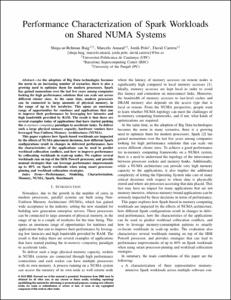Mostra el registre d'ítem simple
Performance Characterization of Spark Workloads on Shared NUMA Systems
| dc.contributor.author | Baig, Shuja-ur-Rehman |
| dc.contributor.author | Amaral, Marcelo |
| dc.contributor.author | Polo, Jordà |
| dc.contributor.author | Carrera, David |
| dc.contributor.other | Barcelona Supercomputing Center |
| dc.date.accessioned | 2018-09-03T13:24:44Z |
| dc.date.available | 2018-09-03T13:24:44Z |
| dc.date.issued | 2018-07-09 |
| dc.identifier.citation | Baig, S. [et al.]. Performance Characterization of Spark Workloads on Shared NUMA Systems. A: "2018 IEEE Fourth International Conference on Big Data Computing Service and Applications (BigDataService)". IEEE, 2018, p. 41-48. |
| dc.identifier.isbn | 978-1-5386-5119-3 |
| dc.identifier.uri | http://hdl.handle.net/2117/120784 |
| dc.description.abstract | As the adoption of Big Data technologies becomes the norm in an increasing number of scenarios, there is also a growing need to optimize them for modern processors. Spark has gained momentum over the last few years among companies looking for high performance solutions that can scale out across different cluster sizes. At the same time, modern processors can be connected to large amounts of physical memory, in the range of up to few terabytes. This opens an enormous range of opportunities for runtimes and applications that aim to improve their performance by leveraging low latencies and high bandwidth provided by RAM. The result is that there are several examples today of applications that have started pushing the in-memory computing paradigm to accelerate tasks. To deliver such a large physical memory capacity, hardware vendors have leveraged Non-Uniform Memory Architectures (NUMA). This paper explores how Spark-based workloads are impacted by the effects of NUMA-placement decisions, how different Spark configurations result in changes in delivered performance, how the characteristics of the applications can be used to predict workload collocation conflicts, and how to improve performance by collocating workloads in scale-up nodes. We explore several workloads run on top of the IBM Power8 processor, and provide manual strategies that can leverage performance improvements up to 40% on Spark workloads when using smart processor-pinning and workload collocation strategies. |
| dc.description.sponsorship | This work is partially supported by the European Research Council (ERC) under the EU Horizon 2020 programme (GA 639595), the Spanish Ministry of Economy, Industry and Competitiveness (TIN2015-65316-P) and the Generalitat de Catalunya (2014-SGR-1051). |
| dc.format.extent | 8 p. |
| dc.language.iso | eng |
| dc.publisher | IEEE |
| dc.subject | Àrees temàtiques de la UPC::Informàtica |
| dc.subject.lcsh | Memory management (Computer science) |
| dc.subject.lcsh | High performance computing |
| dc.subject.other | Performance |
| dc.subject.other | Modeling |
| dc.subject.other | Characterization |
| dc.subject.other | Memory |
| dc.subject.other | NUMA |
| dc.subject.other | Spark |
| dc.subject.other | Benchmark |
| dc.title | Performance Characterization of Spark Workloads on Shared NUMA Systems |
| dc.type | Conference lecture |
| dc.subject.lemac | Gestió de memòria (Informàtica) |
| dc.subject.lemac | Supercomputadors |
| dc.identifier.doi | 10.1109/BigDataService.2018.00015 |
| dc.relation.publisherversion | https://ieeexplore.ieee.org/document/8405690/ |
| dc.rights.access | Open Access |
| dc.description.version | Postprint (author's final draft) |
| dc.relation.projectid | info:eu-repo/grantAgreement/EC/H2020/639595/EU/Holistic Integration of Emerging Supercomputing Technologies/Hi-EST |
| dc.relation.projectid | info:eu-repo/grantAgreement/MINECO//TIN2015-65316-P/ES/COMPUTACION DE ALTAS PRESTACIONES VII/ |
| local.citation.publicationName | 2018 IEEE Fourth International Conference on Big Data Computing Service and Applications (BigDataService) |
| local.citation.startingPage | 41 |
| local.citation.endingPage | 48 |


